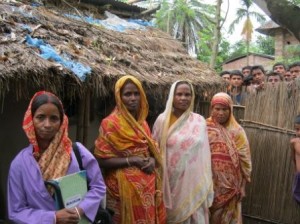(cross-posted on the BRAC blog)
 “I want both my daughter and son to get a job as soon as they’re done with their studies…it may be in Rangpur, it may be in Dhaka…it doesn’t matter….but they must get a job.”
“I want both my daughter and son to get a job as soon as they’re done with their studies…it may be in Rangpur, it may be in Dhaka…it doesn’t matter….but they must get a job.”
This is what Mina apa (pictured, far left), a seasoned shasthya shebika, wants for her 16-year-old daughter and 9-year-old son. As a health worker in the remote village of Bodorgonj, Rangpur, her daily activities are a testament to how much women have advanced over the past four decades, and her dreams for her children offer an insight into changing aspirations in rural Bangladesh that are shaping the country’s future.
Bangladesh is changing. Its cities are growing; rural villagers come to tap into the economic opportunities. “Urbanization” is a buzzword these days; everyone is talking about megacities like Dhaka that will double in population in a few decades (see Building to Last to learn more about BRAC’s work in urban Bangladesh). But the other side of the coin is what happens to villages when people start moving. Having met many urban migrants staying in the slums of Dhaka, we recently went to northeastern Bangladesh, historically a poor region, to learn more about the perspectives of those who stay behind.
Once filled with subsistence farmers tied to the land, rural Bangladesh is increasingly more service-inclined, connected and mobile. In Bodorgonj, for example, very few of the men and boys work in fields full time. Rangpur is prone to seasonal hungry periods (right before the harvest), and many households seek to supplement agriculture with other forms of income. Rangpur city’s growing demand for furniture, light welding and motorcycle repair workshops, bakers, and cigarette manufacturers is just a short ride by bus.
As the center of Bangladesh’s economic growth, to many, Dhaka represents a bigger gamble with higher potential returns. Families saved up (one we met had sold their only goat) to gather the Tk. 500 (US $6) needed to make the 7-hour road trip to Dhaka where jobs as rickshaw pullers and construction workers abound for young, healthy men. Informal social networks are crucial in these journeys; many had bought a second-hand cell phone to make it easier to maintain ties. Men go in groups of 3 to 10, relying on the contacts that they’ve built in previous trips to find work. Despite the hard conditions—exhausting labor and living conditions—for some young men, there is an element of excitement. They see a chance to get a taste of big city life, aiming to earn enough to pay for their week or, month long stay and ride back home. Those with more responsibility often stay for longer with the objective of remitting money back to their village. Longer-term, some buy assets, like a rickshaw and move home for good, and others strive to create a situation secure enough to bring their wives and children to stay with them.
Women are moving too, as the garment manufacturing has created opportunities for women to access jobs in the formal sector. It employs nearly three million people, 80% of whom are adolescent girls and women in their 20s and 30s. These women are increasingly, finding more remunerative work in the booming industry stitching T-shirts, pants and sweaters for Wal-Mart, H&M, Zara and other brands. This occupation is turning some women into primary breadwinners for their families. A recent New York Times article reports that garment factory jobs in Bangladesh may be giving families more financial breathing room, allowing some children to stay in school while others take jobs and support the family. Of course, not all women are lucky enough to secure good garment factory jobs. Many work as maids in middle and high income households for monthly wages less than tk 3000 (US$ 36). Impoverished families sometimes send their children to work as house help in wealthier urban households, creating opportunities for some income (usually between tk 500-tk 1000), but also isolation from their family, heavy workloads, and verbally/physical abuse, according to a recent study conducted by BRAC’s Research and Evaluation Division.
Over 300,000 people come to cities like Dhaka each year, looking for work. Most land at places like Hazaribag, right on the edge of the city. Arrival City describes these places as “…not mere slums…[or] temporary encampments for transient labor. They are the key mechanisms of the city’s regeneration.” People who arrive here are agents with the potential to enrich the city’s ability to regenerate, and through their activities, generate resources to enrich their home villages as well. Creating ways to reduce the costs of mobility and the risks of travel to, and work and life in cities, will ensure that the economic growth of urban areas lifts the whole nation.
Please check out the new video Bangladesh on the move: Reflections on urbanization, for a more in-depth description of how urbanization is changing Bangladesh, nationwide.
Written by Ishtiaque and Maria.